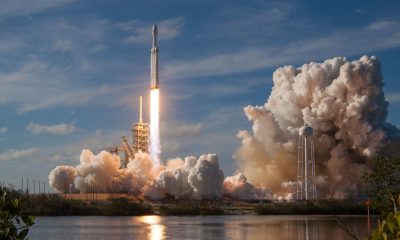Aerospace
Support Local or Save a Billion Dollars – How Can SpaceX Pull off Telesat’s Goal So Cheaply?
Securities.io maintains rigorous editorial standards and may receive compensation from reviewed links. We are not a registered investment adviser and this is not investment advice. Please view our affiliate disclosure.

Last weekend, on Sept. 15, tech-billionaire Elon Musk said that it would take “less than half” the amount to provide Starlink to every Canadian household than what the country's government has provided to its competitor Telesat to achieve the same goal.

The response came after Michael Barrett, a Member of the House of Commons of Canada and Conservative Party Member, condemned the multi-billion dollar deal between the Canadian government and satellite operator Telesat.
“If this $2.14 BILLION plan is the panacea of expanding access, competition, and service — where is the interest from private investors and banks?”
– Barrett on X (previously Twitter)
He further asked Musk to share his remarks on the matter and, on the suggestion of lower cost, opined that Starlink sounds like a “common sense solution” for Canada.
Canada's industry minister, François-Philippe Champagne, dismissed it all as “nonsense.”
“They'd prefer giving money to foreign billionaires instead of supporting our industry and our workers. This loan will help build a world-class Canadian-made satellite network and support thousands of jobs in Quebec! Now that's common sense!”
– Minister of innovation, science and industry
Back in July, Musk shared on X that Starlink has been serving “more than 400k active Canadian customers,” about 3% of households across the country. The people of Quebec City are currently paying about C$140 per month to avail of Starlink's service, while the hardware needed to use the service at home costs C$299.
Starlink is a subsidiary of Musk's SpaceX, which is a company that designs, manufactures, and launches advanced rockets and spacecraft. Internet speeds across its satellites range from 25 to 220 MBps. SpaceX plans to have over 40,000 satellites in orbit, with more than 7,000 already orbiting space.
In response to Champagne's comment, Musk said this week that the Canadian government doesn't want to rely on Starlink but rather wants its “own system” to provide connectivity throughout the country.
While Musk hasn't shared just how he can achieve Telesat's goal at half the amount that it has received from the Canadian government, there are some seemingly obvious ways it can be done.
For starters, SpaceX has already been mass-producing satellites. Building satellites at scale has allowed Starlink to develop efficient satellite manufacturing processes that enable cost savings.
Not to mention, SpaceX's reusable rocket technology drastically cuts launch costs by reusing the same rocket multiple times, and most of its rocket components are also manufactured in-house. These factors allow for tighter control over costs and reduce reliance on external suppliers that may have higher markups.
Musk's US-based company also has advanced launch capabilities, controlling a significant portion of its supply chain, reducing overhead, and cutting middleman costs. Not to mention, having experience with similar projects gives the company an advantage in both experience and cost optimization.
Click here to learn how Musk's endeavors are coming to full circle with X.com.
A Deeper Look at Telesat's $2.54 Billion Government Funding

Last week, the Canadian satellite communications company Telesat, with its headquarters in Ottawa, secured investment agreements worth $2.54 billion with the Government of Canada and the Government of Quebec. This funding, Prime Minister Justin Trudeau said, showcases the government's commitment to focus on Canadians in action.
“Designed, manufactured, and operated in Canada – the Telesat Lightspeed satellite network will be the largest in Canadian history – creating thousands of jobs, growing our economy, and getting high-speed internet to Canadians. We're putting Canada at the forefront of opportunity, with a fair chance for everyone to succeed.”
– Trudeau
For a clear picture, the Canadian government loaned Telesat $1.57 billion (CAD 2.14 billion), maturing it by 15 years. The government is also receiving warrants for 10% of the common shares of the company based on a $3 billion equity valuation of Telesat LEO, which is a Telesat subsidiary and the official borrower.
Meanwhile, the loan from the Quebec Government is for $294 million (CAD 400 million) with warrants for 1.87% of the common shares. According to Dan Goldberg, the President and CEO of Telesat:
“We are pleased to conclude these funding arrangements with the governments of Canada and Quebec as we make strong progress on the build-out of the revolutionary Telesat Lightspeed constellation, the largest space program in Canada's history.”
With this funding, Telesat has all its bases covered to pay for its $3.5 billion Lightspeed network, which includes satellites, launch vehicles, landing stations, and operational support systems. The launch of the company's first Lightspeed satellites, however, won't come until mid-2026, with 2027 as the go-live date.
The Lightspeed network of Telesat is made of 198 advanced Low Earth Orbit (LEO) satellites integrated with on-ground data networks and offers a very high level of flexibility in capacity allocation.
The next-gen technology used by Lightspeed Network involves hybrid orbits that provide complete global coverage with higher capacity where most of the world's population lives. Through optical inter-satellite links, a fully interconnected global mesh network is created to allow users to access the Network regardless of their location.
Each of the satellites here has phased array antennas with hopping beams that scan the earth to provide full coverage. Moreover, data processing occurs in space to offer higher capacity and flexibility.
Telesat Lightspeed, according to Goldberg, will “help bridge the digital divide in Canada and throughout the world.” It would also create thousands of high-quality jobs in the North American country, as many as 2,000 as per a news release from the Office of the Prime Minister.
The investment, according to Trudeau, is about enabling people in the remotest part of Canada, including indigenous communities, to connect with more reliable and cheaper internet with the help of Telesat's Lightspeed LEO broadband satellite constellation.
“Yes, it's about investing in satellites and space and all sorts of really cool stuff,” said Trudeau in an interview, adding, “But it's fundamentally about making sure that Canadians and people in more distant communities, in smaller northern communities and in remote parts of the world can be connected to the transformation and the progress that the world is seeing at increasingly destabilizing speeds.”
Moreover, the funding will spur domestic innovation and supply billions of dollars of investment in the local economy. All of these factors together will help put Quebec and Canada at the “forefront of the rapidly growing New Space Economy,” said the Telesat CEO.
Quebec Premier François Legault meanwhile emphasized the importance of the aerospace sector to the province, which has three of the world's biggest airplane manufacturers. However, planes are not the only element critical to the sector's future; rather, they increasingly rely on satellites. So, to become “the champion of aerospace, we have to be in satellites,” Legault said.
Aerospace technology firm MDA, meanwhile, has been contracted to build the 750-kilogram satellites in Ste-Anne-de-Bellevue, Quebec. The company announced separately that it had started work on a 185,000-square-foot expansion of this facility, which would double its capacity to “create the most advanced assembly line for satellites in the world” and meet future demand.
The road to gaining funding from the government hasn't been smooth for Telesat, though, as it involved years of negotiations as well as delays for the project. Initially, the project was actually planned to be larger and more expensive and was to be built by Thales Alenia Space before the pandemic caused disruption.
But now it has been secured, and over the past year, Telesat has increased its local workforce by about a third in preparation for spending CAD 1.4 billion on the project this year.
Telesat's commercial Lightspeed services, meanwhile, are due in 2027, which will put the company in competition with Starlink and OneWeb. Interestingly, Internet giant Amazon is also expected to launch its Project Kuiper this year.
#1. Telesat: Pioneering Canada's Satellite Industry
Founded in 1969, Telesat is a Canadian company that provides communications solutions through sophisticated satellites. It operates through two segments, geostationary (GEO) and Low Earth Orbit (LEO), and provides its services through Broadcast, Enterprise, and Consulting categories.
Telesat Corporation (TSAT -1.48%)
Boasting more than half a century-long track record of expertise and innovation, Telesat has the largest space program in Canada. The company has a market cap of almost $530 million, and its shares are currently trading at $10.69, up 2.49% year-to-date (YTD). As per the data provided by CNBC, Telesat has an EPS (TTM) of 1.49, a P/E (TTM) of 7.16, and an ROE (TTM) of 4.29%.
For Q2 of 2024, the company reported revenue of CA$152.4 million, down 15% from the same period last year. Net income, meanwhile, was CA$35.5 million while profit margin was 23%, representing a decrease of 75% and 78%, respectively, in 2Q 2023. Moreover, the adjusted EBITDA for the quarter was $103 million, and the adjusted EBITDA margin was 67.8%.
The decline in the company's revenue was due to a reduction of services, a lower rate of DTH renewals, and lower revenue from mobility while the company increased its capital expenditures for the Lightspeed constellation. The drop, however, was in line with expectations, and Telesat maintained its 2024 outlook with revenue between CA $545 million and CA $565 million, which is a 21% YoY reduction at the midpoint.
“We're hugely bullish on our prospects in the market as well as our ability to deliver an extraordinary value proposition for our customers and significant value creation for our shareholders.”
– CEO Goldberg during Telesat's earnings call
This week, Telesat announced that Ottawa-based Calian's Element Management System (EMS) technology will play a key role in Lightspeed's network operations and maintaining optimal performance. The company also hired retired Brig. Gen. G. Michael Adamson will lead its defense strategy. Earlier this month, the company sold off the remote satellite services specialist, Infosat Communications, to support its finances in the LEO Lightspeed constellation.
In August last year, the telecommunications satellite operator swapped its French-Italian manufacturer Thales Alenia Space with Canadian MDA for its Lightspeed network, which helped it save about $2 billion.
Then, the following month, it signed a deal with its competitor SpaceX to launch 14 of its Lightspeed internet satellites. For its 2026 mission, Telesat will use Falcon 9 rockets, which CEO Goldberg heralded as a “great value proposition” due to being reliable, affordable, and having the ability to launch multiple satellites a week. “It's phenomenal,” said Goldberg.
Years ago, Telesat also signed an agreement with Blue Origin to use its New Glenn rocket, but the rocket has yet to be launched. The company's agreement with Jeff Bezos' company is still in place, though.
#2. SpaceX: Revolutionizing Space Travel and Global Connectivity
Launched in 2002, SpaceX is a company privately owned by Musk. It is designed to create commercial spaceflight, reduce the cost of space travel, and develop a colony on Mars. Ever since its inception, SpaceX has been making progress in the aerospace industry, with Starlink being one of its most innovative advancements.
The company reported $9 billion in revenue in 2023, which is projected to increase to $15 billion this year. SpaceX's valuation also jumped to $180 billion late last year.
According to a TechCrunch report, 2018 and 2019 were pivotal years for the company, as it was during this time that SpaceX launched its Falcon Heavy rocket and its first 60 Starlink satellites. In 2018, its revenue was $1.98 billion, while $1.45 billion was recorded the following year, with operating net loss coming in at $308 million and $501 million, respectively. The company reportedly spent a lot of cash on research and development.
Before Starlink fully went into motion, NASA contracts accounted for 37% of SpaceX's revenue in 2018 and a whopping 83% in 2019.
Meanwhile, a report from WSJ noted that some of the people who have invested in SpaceX do not know just “how much money the company makes or loses.” In fact, many of its “investors view their holdings as a long-term bet and say they aren't concerned about seeing results.”
WSJ further reported SpaceX generated a $55 million profit on $1.5 billion in revenue, which “came after two years of significant but narrowing losses.” For 2022, the company reported $5.2 billion in expenses. Revenue meanwhile doubled to $4.6 billion, which brought down its losses last year to $559 million from $968 million.
Starlink, in particular, has been playing a key role in SpaceX, which has used its rockets to launch satellites even for companies that compete directly or indirectly with its internet network. As we noted above, Telesat is one such example, with Viasat, EchoStar, and OneWeb being other ones. Starlink has more than 2.5 million customers.
The company currently has its sights set on launching the first Mars mission, which is scheduled for 2026 during the Earth-Mars transfer window occurring every 26 months. Talking about the mission, CEO Musk noted that the Starships would be uncrewed to test the reliability of an intact Mars landing, and only if that goes well, crewed flights will be made in four years. He wrote on X:
“Flight rate will grow exponentially from there, with the goal of building a self-sustaining city in about 20 years. Being multiplanetary will vastly increase the probable lifespan of consciousness, as we will no longer have all our eggs, literally and metabolically, on one planet.”
Amidst this, Musk criticized the leadership of the Federal Aviation Administration (FAA) for “spending resources to attack” his company for small matters. This includes the FAA's claim that SpaceX failed to follow US regulations during two rocket launches, and these alleged violations involved $633K in fines.
These distractions, as per his letter to Congress, “threaten national priorities and undercut American industry's ability to innovate.” He further complained about the agency's “inability to keep pace with the commercial spaceflight industry.”
Conclusion
So, as we noted, the government wants to give priority to a local company while Musk is offering affordable solutions for expanding internet access, as already seen with Starlink. While it's understandable for a nation to build its very own system instead of being dependent on others, for the end user, Starlink's capability to manufacture and launch satellites makes far more sense in terms of getting the cost benefits.
This only highlights the larger debate on public vs. private investment in space technology, with both paths promising to bridge the digital divide. Ultimately, governments have to balance between fostering domestic growth and leveraging the capabilities of global innovators for more effective solutions.
Click here to learn all about the future space-based economy.












